Attacking phases incorporating wing backs

| Area | Up to full pitch |
| Equipment | Balls, bibs, cones, 2 full size goals |
| No. of Players | Up to 17 players + 2 goalkeepers |
| Session Time | Wing back crossing: 20mins Progression: 20mins |
This session encourages the wing backs to make decisions in different types of attacking situations, whether in the build-up phase, a switch of play or a transition. The outcomes we look for are defined based on the wing back’s use of options – whether to pass, cross, switch, or shoot.
The session allows for ownership of the wing back role within the team, creating multiple potential outcomes based on real game situations. It highlights the importance of the wing back within the team.
We value this session enough to work on it weekly, either on Match Day –2 or when we feel the need to work on a tactical understanding of the role.
“This session allows for ownership of the wing back role within the team, creating multiple potential outcomes based on real game situations”
WING BACK CROSSING
We set up a playing area using the whole pitch. An area the width of the penalty area is marked out the length of the pitch, and an area in line with the edges of the centre circle is marked out across the pitch, creating three zones. There is a full size goal and a goalkeeper at each end.
The blue attacking team have two centre forwards in each end zone, three centre midfielders in the middle zone, and two wing backs on each side. The red team have three defenders in each end zone.
There is a coach on either side with balls. The coach plays the ball into the defensive centre midfielder who chooses to attack the goal on the right. The midfielder plays the ball to the centre forward, who lays it off to an oncoming attacking centre midfielder. The midfielder plays a pass out wide for the wing back to run onto. The wing back then drives forward, while the wing back on the opposite side moves up a zone, as shown [1a].
[1a]
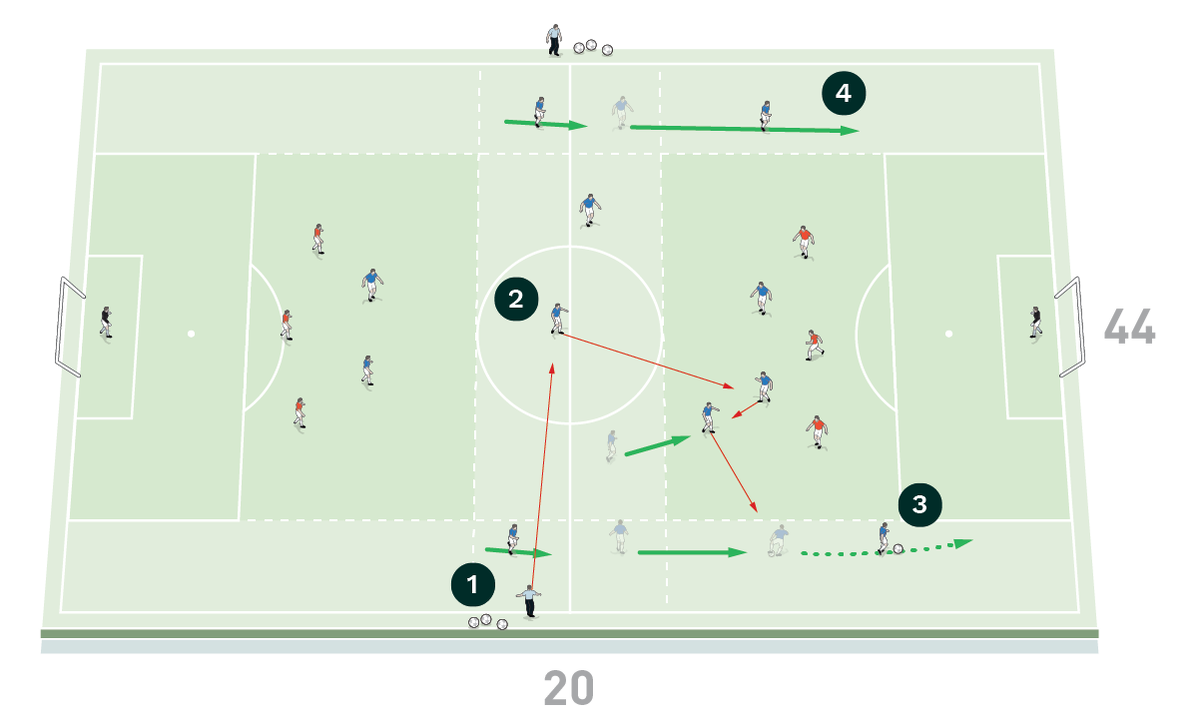
- The coach plays the ball into the defensive centre midfielder who chooses to attack the goal on the right
- The midfielder plays the ball to the centre forward, who lays it off to an oncoming attacking centre midfielder
- The midfielder plays a pass out wide for the wing back to run onto. The wing back then drives forward
- The wingback on the opposite side moves up a zone
The wing back crosses the ball into the box. The centre forwards and two centre midfielders make runs into the box, while the other wing back runs to the back post. The defensive centre midfielder sits just outside of the box, as shown [1b].
[1b]
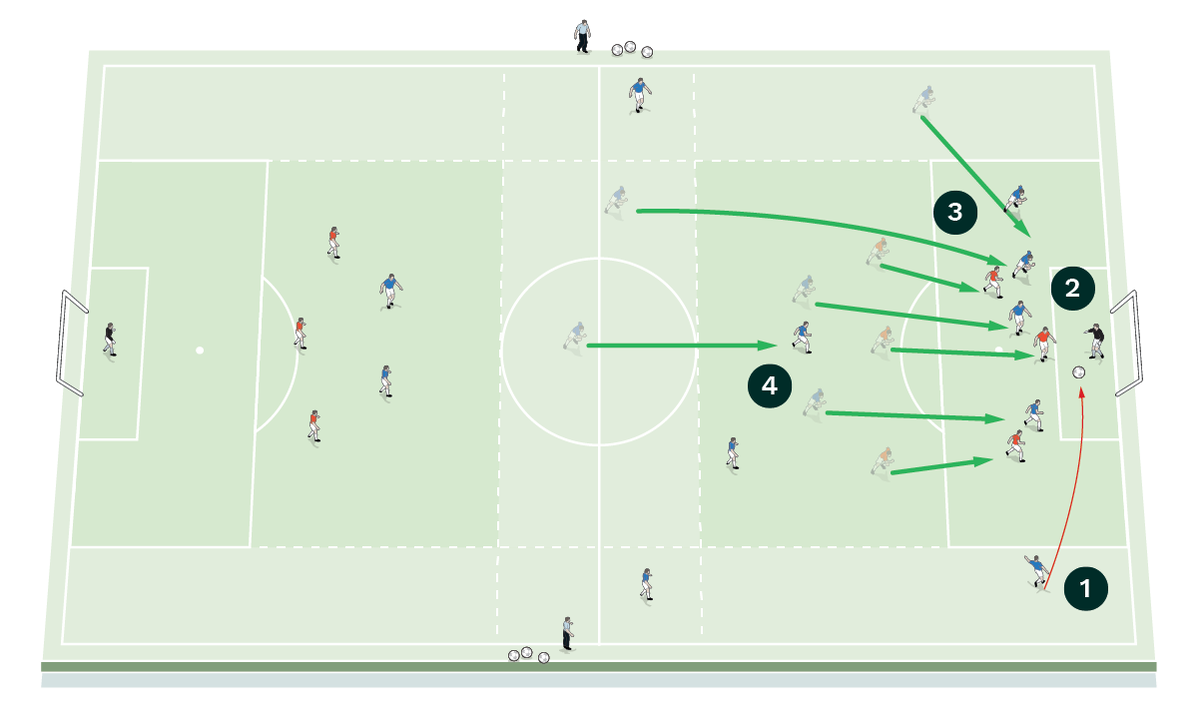
- The wing back crosses the ball into the penalty box
- The centre forwards and two centre midfielders make runs into the box
- The opposite wing back runs to the back post
- The defensive centre midfielder sits just outside of the box
Either the attack is cleared and the defensive centre midfielder picks the ball up and plays it out wide for the wing back to cross it back into the box again, as shown [1c], or the attack is completed and the coach plays a pass into the defensive centre midfielder to restart play.
[1c]
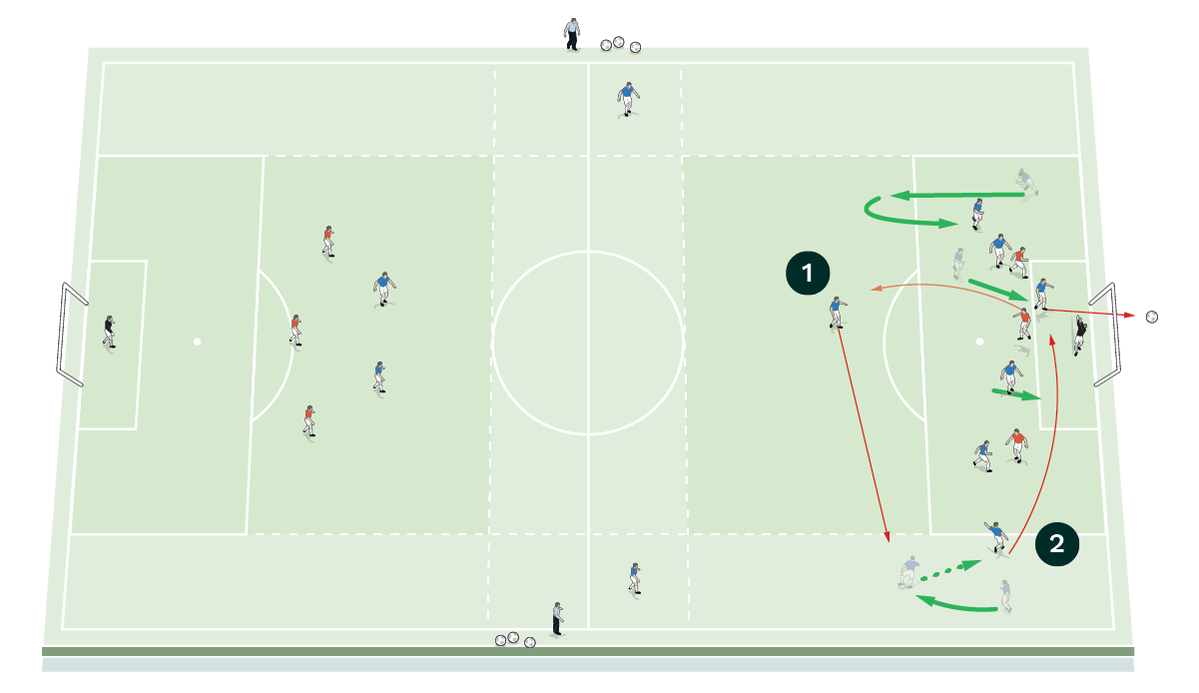
- If the attack is cleared, the defensive centre mid picks up the ball and plays it out wide again for the wing back
- The wing back crosses it back into the penalty box
Following the completion of the play, the coach serves a new ball to the defensive centre midfielder. The midfielder switches the play to the wing back, who passes to the centre forward. The opposite wing back supports inside to create a 3v3, while the wing back that played the pass runs down the wide channel to keep the width and create a 4v3 overload, as shown [1d].
[1d]
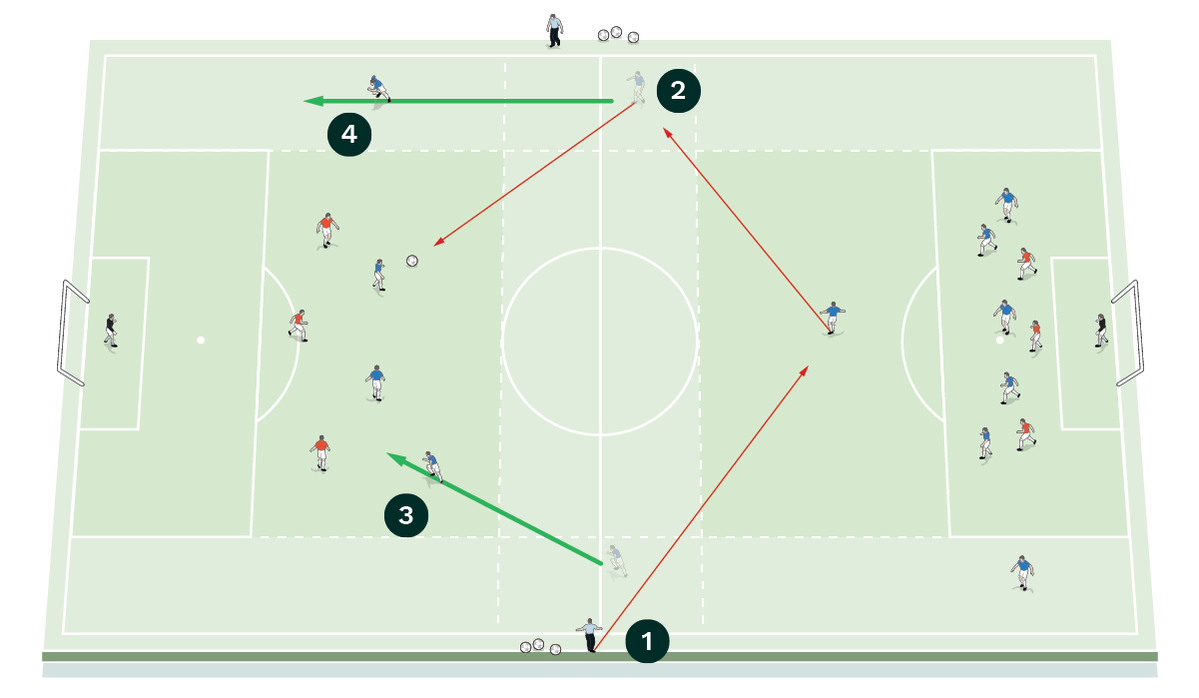
- Play always restarts from the coach playing a ball to the defensive centre midfielder
- The midfielder switches the play to the wing back, who passes to the centre forward
- The opposite wing back supports inside to create a 3v3
- The wing back that played the pass runs down the wing to keep the width and create a 4v3 overload
PROGRESSION
As a progression, two red defensive midfielders are added to the play. The coach restarts by passing to a blue defensive centre midfielder who switches it to the deep wing back. The centre forward runs into the channel to receive the ball, as shown [2a].
[2a]
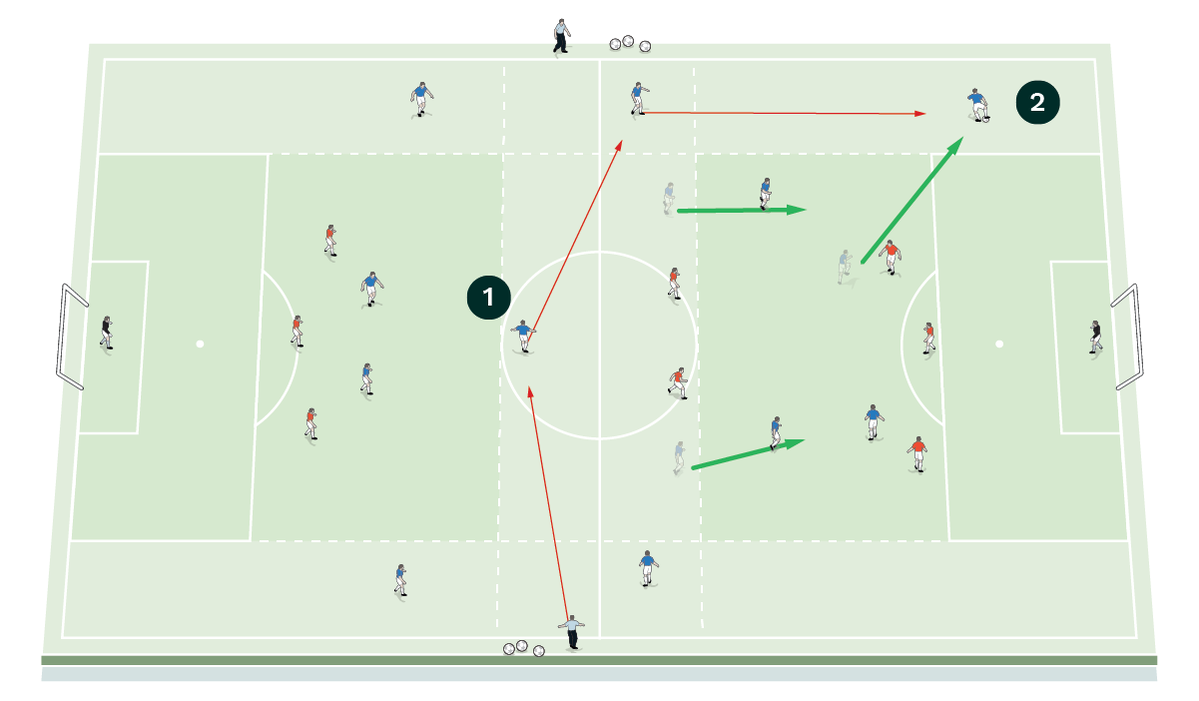
- The coach plays the ball to a blue defensive centre midfielder who switches it to the deep wing back
- The centre forward runs into the wide channel to receive the ball
The players then combine on the wing before switching the attack, playing the ball to the wing back on the opposite side through the centre defensive midfielder, as shown [2b].
[2b]

- The players combine on the wing before switching the attack
- The ball is played to the wing back on the opposite side through the centre defensive midfielder
The wing back plays the ball into the box, this time from a deeper position. The blue midfielders, strikers and opposite wing back run into the box to finish the cross, as shown [2c].
[2c]
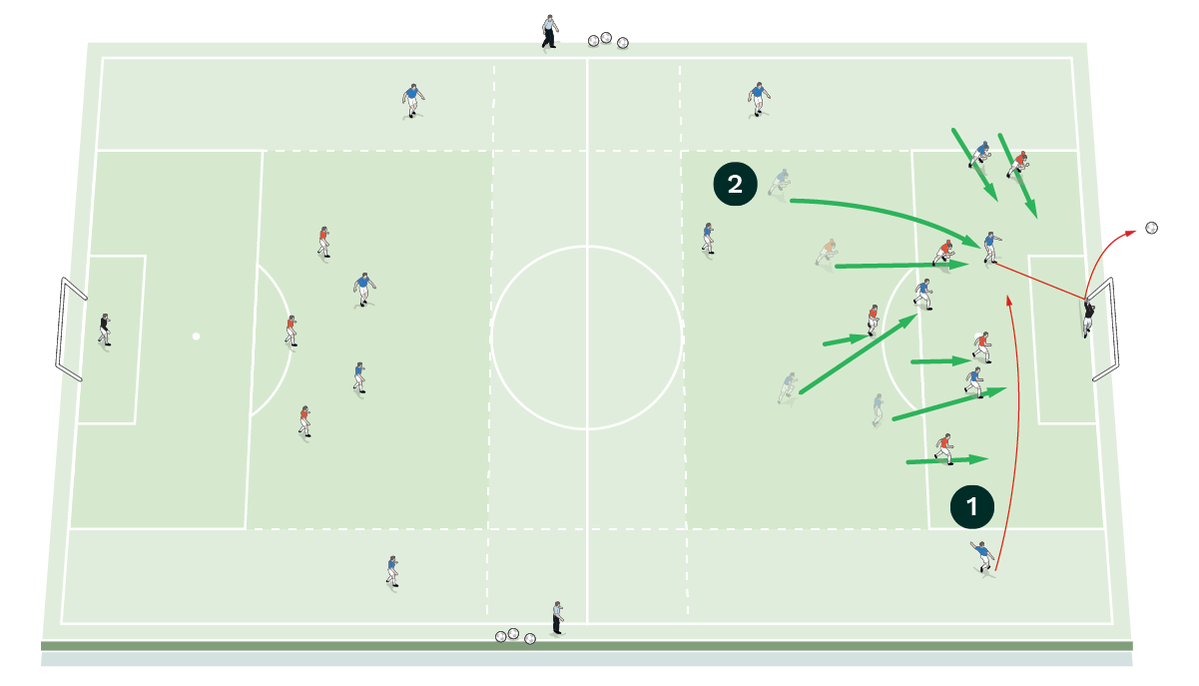
- The wing back plays the ball into the box, this time from a deeper position
- The blue midfielders, strikers and opposite wing back make runs into the box to finish the cross
“What we want the wing backs to recognise is when and where to attack space and how to support the attack”
COACHING POINTS
What are the key things to look out for?
What we want the wing backs to recognise is when and where to attack space. We want them to understand how to support the attack. This includes knowing how to supply the attack with changes, meaning when to cross or pass; the type of cross to use; how and why to switch play; and when to support through central areas. The end products should be crosses, shots, goals and sustained pressure on the opponent’s goal.
What are the typical mistakes players might make and how do I avoid them?
Typically, the role of the wing back requires stamina, so the understanding of when to arrive in the space, or when to support a build-up is important. An example of a mistake is closing down space too early, which will invite defensive numbers to block potential crossing or passing zones.
Sometimes ball watching players can forget that the back post can be attacked when the opposite wing back is crossing.
Editor's Picks
Attacking transitions
Deep runs in the final third
Using the goalkeeper in build-up play
Intensive boxes drill with goals
Penetrating the final third
Creating and finishing
My philosophy
Pressing initiation
Compact team movement
Coaches' Testimonials

Alan Pardew

Arsène Wenger

Brendan Rodgers

Carlos Carvalhal

José Mourinho

Jürgen Klopp

Pep Guardiola

Roy Hodgson

Sir Alex Ferguson

Steven Gerrard
Coaches' Testimonials

Gerald Kearney, Downtown Las Vegas Soccer Club

Paul Butler, Florida, USA

Rick Shields, Springboro, USA

Tony Green, Pierrefonds Titans, Quebec, Canada
Join the world's leading coaches and managers and discover for yourself one of the best kept secrets in coaching. No other training tool on the planet is written or read by the calibre of names you’ll find in Elite Soccer.
In a recent survey 92% of subscribers said Elite Soccer makes them more confident, 89% said it makes them a more effective coach and 91% said it makes them more inspired.
Get Monthly Inspiration
All the latest techniques and approaches
Since 2010 Elite Soccer has given subscribers exclusive insight into the training ground practices of the world’s best coaches. Published in partnership with the League Managers Association we have unparalleled access to the leading lights in the English leagues, as well as a host of international managers.
Elite Soccer exclusively features sessions written by the coaches themselves. There are no observed sessions and no sessions “in the style of”, just first-hand advice delivered direct to you from the coach.









